

In the Nile Valley
Train Operation in Modern Egypt
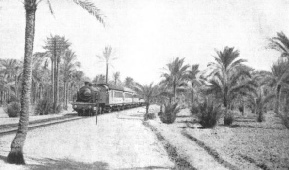
A PASSENGER TRAIN IN EGYPT. The first railway in Egypt and the first on the African continent was begun between Alexandria and Cairo in 1852 and opened throughout in 1856. To-
THE total area of Egypt proper, including the Libyan Desert, the region between the Nile and the Red Sea, and the Sinai Peninsula, is about 383,000 square miles. But the cultivated and settled area consists only of the long narrow Nile Valley and the triangular delta, a total area of about 12,400 square miles. Egypt’s historical importance need not be stressed in this chapter. The country has become a favourite winter resort of Europeans.
Egypt was for many years an important part of the “overland route” to India and the East. This route was established in 1842. Mails, passengers, stores, and baggage were disembarked at Alexandria and carried across the desert to Suez. The P. & O. Company at one time owned 3,000 camels, which were employed on this service; the passengers, however, travelled in rough horse-
This was the first railway on the African continent, and the first section begun in 1852, was opened to Kafr-
The line from Cairo southwards was next undertaken; by 1874 it was completed as far Assiut, a large town on the banks of the Nile, about 230 mile from Cairo. Luxor, 340 miles from Cairo, was reached in 1898, the Nile having been crossed again at Nag-
The section between Kena and Luxor was built to the standard gauge, and that between Luxor and Aswan to a gauge of 3 ft 6-
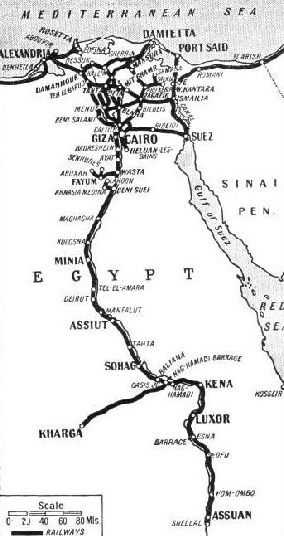
THE EGYPTIAN STATE RAILWAYS own some 2,195 miles of standard gauge track, and a number of auxiliary lines. The State Railways are linked with the Egyptian Delta Light Railways, a narrow-
The policy of the State Railways Administration has been the gradual absorption of private lines in Lower Egypt. The Heluan Railway was built between 1870 and 1872 by the Khedive of that time, Ismail Pasha. It was operated as a State railway until 1888, when a working concession was granted to Suares Frères; the line was subsequently transferred to the Delta Light Railway Company. In 1914 the Government resumed working of the railway.
The Mariut Railway was originally constructed and worked by the Khedive, Abbas Hilmi, as his private property; it extends from Wardian to Abu Hagag (148 miles), part being standard and part narrow gauge. It was purchased by the Government in 1914. During the war of 1914-
During the war the question of rail connection between Egypt and Palestine arose. In 1915 a standard gauge line for military purposes, running east from Kantara East, was begun. By the end of 1918 it was completed as far as Haita. Until 1917 a train ferry was used for the exchange of rolling stock between the Egyptian State Railways and the military railways of Palestine over the Suez Canal. But, in view of the need for more speedy transit between Egypt and Palestine, the Suez Canal Company agreed to the building of a swing bridge across the canal at a point three miles north of Kantara, on condition that it was removed after the war. The bridge was built in five months, and opened in July, 1918. Interchange of wagons and through bookings of goods traffic between Egypt and Palestine is still carried on by train ferry service across the canal, the tonnage of goods amounting to a very large annual total. Goods can be put on trucks at any station on the Egyptian State Railways and unloaded at any station on the Palestine Railways. There is a system of controlling the rolling stock exchanged, and, if trucks of one system are delayed on the other system beyond the allowed period, demurrage is enforced.
From a railway point of view Egypt offered an ideal field for exploitation. Construction was easy and economical, almost the only major works being the Nile bridges. Gradients are practically non-
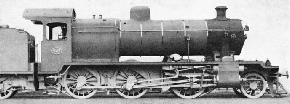
MIXED TRAFFIC LOCOMOTIVE built for the Egyptian State Railways by the North British Locomotive Company, Ltd. This 2-
Increase in weight and speed of traffic led to the adoption of heavier rails, and in 1912 the Vignoles (flat-
Between 1925 and 1932 the track underwent extensive renewal. During the war it had deteriorated, as maintenance and renewal had been suspended because all available material and labour were required for military purposes, The central permanent way shops are at Gabbary (Alexandria), where they are conveniently placed for the reception of materials from abroad.
Engines Built Abroad
The signalling employed is absolute lock and block similar to that in England. In general it is mechanical, both Tyers and Sykes’ block instruments being used, but at Cairo Main Station the Westinghouse electro-
The installation at Cairo Station has been renewed on up-
There are nine railway bridges over the Nile, the most important being the Embaba Bridge. This bridge was renewed in 1924, and carries a double line of rails and a roadway on either side, with foot ways above. It has six fixed spans and one swing span, and the total length is 1,608 ft. The swing span can be operated electrically or by hand. The Dessouk Bridge is a single line bridge over the Rosetta branch of the Nile, and was opened in 1927. This bridge is in two sections joining a centre island, one section having a swing and five fixed spans and the other four fixed spans. There is a roadway on either side of the bridge.
The number of locomotives possessed by the Egyptian State Railways is over 600, all of which have been built abroad; but many are over thirty years old and are gradually being replaced by more modern engines. The principal locomotive and carriage shops are at Bulak, Cairo, but they are now being transferred to Abu-
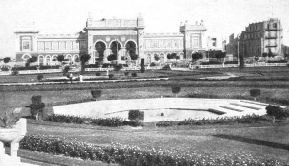
ALEXANDRIA STATION. Between this station and Cairo there are seven express trains operating daily in either direction The journey of 120 miles is covered in from two and a half to three and a quarter hours. Apart from the large volume of passenger traffic arriving at and departing from the city. Alexandria has the largest goods station In Egypt.
There are four locomotive districts -
Experiments with a steam rail-
Ten streamlined Diesel rail-
Rail-
These are the first rail-
Passengers carried on the Egyptian State Railways in the year 1933-
Large numbers of tourists are carried during the winter season, special trains being run to and from the quays at Alexandria for their conveyance. Luxurious liners leave Europe for Egypt several times a week, and giant multi-
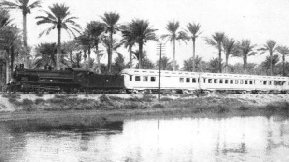
LUXURY COACHES for special functions and state occasions are maintained by the Egyptian State Railways. This picture shows the train used by the King of Egypt and his suite.
On the platform of the imposing station at Cairo waits a crowd which is an amazing medley of types and variety of costume, with hotel-
Seen from the Pyramids across the green strip of the Nile Valley, Cairo seems to be dominated by the pointed silhouette of the Citadel among a sea of roofs, domes, and minarets. In the Musky, or bazaars, of Cairo is to be found a collection of glassware, copper, gold, carpets, beads, shawls, and perfumes, whose heady scent mixes with the aroma of coffee and cigarettes and with that of the frying confections from neighbouring restaurants.
The “Sunshine Express”, a luxury train composed of restaurant and sleeping cars, takes passengers to Upper Egypt in a single night, and Abydos, Dendera, Thebes, Karnak. Luxor, Edfu, and Aswan soon become so many familiar names. Combined tickets between Cairo, Luxor, Aswan, and Shellal, including fares and sleeper and hotel accommodation, are issued at cheap rates during certain months. There are three trains a day in either direction between Cairo and Luxor, the journey of 340 miles taking about twelve hours. To Aswan and Shellal, there are two trains a day in either direction which cover the distance of 480 miles in about seventeen hours.

THIRTY-
At Aswan the aspect of the country changes considerably. From the garden of the Cataract Hotel may be seen here and there, smoothed by the action of the water, the first blocks of that black stone whose high walls are soon to be seen enclosing the Nile as in a corridor. Beyond are the rapids leading up to the great Dam which now controls the waters of the Nile; when it lets them accumulate they rise above the temples of the island of Philæ; but when the sluices are opened the waters subside, leaving the island to glisten in the sun. Then comes the Sudan with its beehive huts, big game, vast deserts, swamps, and equatorial forests.
Between Alexandria and Cairo there are seven express trains a day in either direction, taking from two and a half to three and a quarter hours for the journey of 120 miles. Greater first-
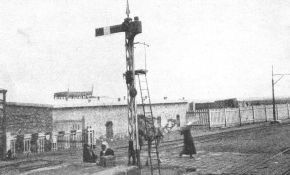
A LEVEL-
An indication of the popularising of railway travel in Egypt is found in the running in the spring of 1935 of two excursion trains which left Cairo for an unknown destination. Some 2,100 passengers travelled on the trains, and so popular was the idea that about 3,000 intending passengers were turned away. The trains ran to lsmailia, a distance of ninety-
The Main Station in Cairo is the largest passenger station in Egypt. It has nine platforms, with a total length of 2,180 yards, and deals with over 10,000 passengers daily. The station is worked from four signal-
In a recent report made by Sir Felix Pole, formerly General Manager of the Great Western Railway, to the Egyptian Minister of Communications, the immediate electrification of the Cairo-
Goods traffic for the year 1933-
Prospects of Development
A Traffic Train Control Office, equipped with a complete system of telephone control, was established at Assiut in 1926 to regulate the traffic of the Mallawi-
The Egyptian State Railways are organised on the departmental system, controlled by a Supreme Railway Board under the presidency of the Minister of Communications. The members of the Board consist of some of the highest officials in the land. The General Manager, at the time of writing, is H. E. Mahmoud Shaker Bey, and the heads of the various departments are directly responsible to him.
The total strength of the staff of the Egyptian State Railways is approximately 33,000, which includes the staff of the Egyptian Telegraph and Telephone Service. An Inspector-
Future prospects of the Egyptian State Railways are bright. Traffic is increasing, and the earnings for the last two or three years have been satisfactory. Suburban traffic in and around Cairo is heavy and, with the electrification of the Heluan and Matariya lines, should develop still further. In the past the only competitor was the river, which was not able to do much either in volume or in speed.
More as a means of counteracting competition than with a view to traffic development, services by road and water were inaugurated by the State Railways in 1930-
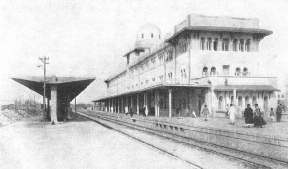
AN ORIENTAL ASPECT is presented by this station, Tanta, on the main line between Alexandria and Cairo. Tanta is an important junction.
You can read more on
and
and
on this website.